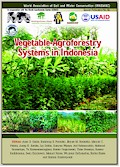| Book Chapter |
 |
|
| Title | Smallholder cultivation of katuk (Sauropus androgynous) and kucai (Allium odorum): challenges in sustaining commercial production and market linkage | | Author | James M Roshetko, Iwan Kurniawan and Suseno Budidarsono | | Editors | Anas D Susila, Bambang S. Purwoko, James M Roshetko, Manuel C. Palada, Juang G. Kartika, Lia Dahlia, Kusuma Wijaya, Arif Rahmanulloh, Mahmud Raimadoya, Tri Koesoemaningtyas, Herien Puspitawati, Tisna Prasetyo, Suseno Budidarsono, Iwan Kurniawan, Manuel Reyes, Wanraya Suthumchai, Karika Kunta and Samran Sombatpanit | | Year | 2012 | | Book Title | Vegetable-agroforestry systems in Indonesia | | Publisher | World Association of Soil and Water Conservation (WASWAC), Bangkok, Thailand and the World Agroforestry Center (ICRAF), Nairobi, Kenya | | City of Publication | Bangkok, Thailand | | Number of Pages of the book | 15 | | Pages | 215-230 | | Call Number | BC0332-12 | | Keywords | Market linkage, smallholder farmer, vegetable agroforestry systems (VAFs), rapid market appraisal (RMA) |
|
| Abstract: |
The development of smallholder faun enterprises is usually concerned
with commercialization to increase farm incomes. Once the farmers have made
decisions of what commodity to produce, they must decide on how to allocate
their available resources to achieve the best output. Smallholder vegetable pro-
ducers face some major uncertainties which impose difficult planning horizons. In
many cases, vegetables reach a stage close to harvest, but the crop does not meet
market specifications, or insects and disease cause significant damage and loss of
marketability. An action research study was conducted to (1) identify the key fac-
tors that motivate smallholder fanners to adopt commercial-oriented vegetable
production and create and maintain market linkages of their vegetable products
and (2) implement possible interventions that enable farmers to overcome market-
ing problems and capture market opportunities.
Data and information were collected using a Rapid Market Appraisal
(RMA) methodology. Small landholdings, a shortage of household labor, and
limited market information often limit the diversification and expansion of vege-
table production. In managing their systems, farmers show a preference for famil-
iar crops and technologies. Most smallholders are reluctant to adopt new innova-
tions that have not been proven successful. Key factors that motivate smallholder
farmers to adopt commercial-oriented technologies and create and maintain mar-
ket linkage are: 1) a stable commodity price, 2) knowing the best management
practices for commodity production, 3) intensive early facilitation to identify and
develop production and market opportunities, 4) clear farmer group goals and
mission, and 5) informative success stories. The following interventions proved
successful in addressing farmers' marketing problems: training in group dynam-
ics, training in pest and disease management, implementation of best practice pro-
duction techniques and distribution of market information among farmers. |
|